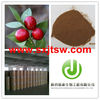- Contact Person : Ms. Xu Lisa
- Company Name : Shaanxi Jintai Biological Engineering Co., Ltd.
- Tel : 86-029-88252883 88210958
- Fax : 86-029-88252883
- Address : Shanxi,Xi'an,263 South Road, Xi'an Taibai a new generation of international C1503
- Country/Region : China
- Zip : 710065
Related Product Searches:butcher's broom extract powder,High Quality,butcher's broom extract powder, natural butcher's broom extract powder,10% 20%
| Product Name | Butcher's Broom Extract | ||
| Latin Name | Ruscus aculeatus Linn. | ||
| Plant part used | Roots | ||
| Active Ingredient | Ruscogenins (Ruscogenin & Neo-Ruscogenin) | ||
| Specification | 10%, 20% Ruscogenins HPLC | ||
| Test Method | HPLC | ||
| Case No | 472-11-7 | ||
| Main Function | Circulation and Cardiovascular Support, Anti-inflammatory | ||
Butcher's broom, Ruscus aculeatus, is a low evergreen Eurasian shrub of the lily family (Liliaceae), with flat shoots known as cladodes that give the appearance of stiff, spine-tipped leaves. Small greenish flowers appear in spring, and are borne singly in the centre of the cladodes. The female flowers are followed by a red berry, and the seeds are bird-distributed, but the plant also spreads vegetatively by means of rhizomes. Ruscus aculeatus is very hardy, thriving in almost any soil or situation, its root is thick, striking deep into the ground. When dry, it is brownish grey, 2 to 4 inches long and 1/3 inch in diameter, having somewhat crowded rings and rounded stem scars on the upper surface and many woody rootlets below. If a transverse section be made, a number of vascular bundles in the central portion are to be seen. It is often planted in shrubberies or edges of woods, on account of its remaining green after the deciduous trees have shed their leaves. It is also widely planted in gardens, and has spread as a garden escape in many areas outside its native range. The matured branches used to be bound into bundles and sold to butchers for sweeping their blocks, hence the name: Butcher's Broom. It is frequently made into besoms in Italy.The young shoots of Butcher's Broom in Spring have often been eaten like those of the Asparagus, a plant to which it is closely allied. The roots or rhizomes for medicinal uses are collected and prepared in autumn. The root has no odor, but its taste is sweetish at first and then slightly acrid. The plant has a long history of use. More than 2000 years ago, it was noted as a laxative, diuretic, and a phlebotherapeutic (beneficial to veins) agent. Extracts, decoctions, and poultices have been used throughout the ages, but the medicinal use of this plant did not become common until the last century. Early investigations during the 1950s indicated that extracts of butcher's broom could induce vasoconstriction and therefore might have use in the treatment of circulatory diseases. The increasing popularity of natural and herbal remedies in Europe in the 1970s reaffirmed its position in modern medicine. Novel uses for this plant have included its use as an anti-inflammatory agent and to prevent atherosclerosis.The Butcher’s Broom Extract used in dietary supplements is derived from the roots of Ruscus aculeatus Linn.Benefits • Improve chronic venous insufficiency• Treat Varicose veins• Prevent Atherosclerosis• Vasoconstriction (blood vessel narrowing) effects• Tone up a sluggish venous system and reduces capillary fragility• Treat venous circulatory disorders (especially for women complaining of a heavy sensation in the legs, and leg cramps, itching and swelling)• Enzymatic effect reduces pain and swelling• Treat hemorrhoids• Anti-inflammatory
butcher's broom extract powder



